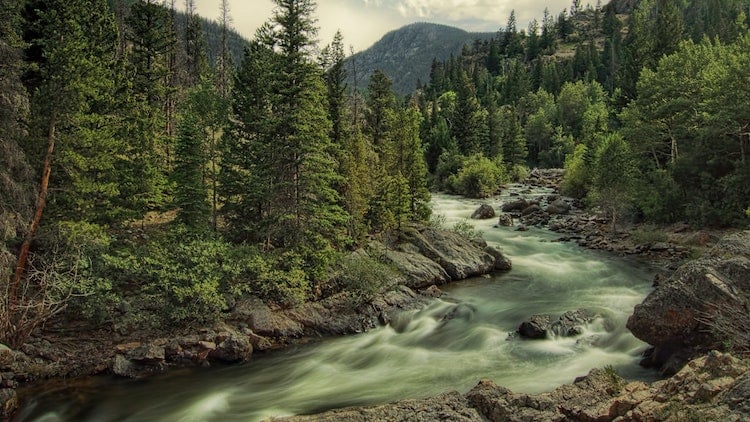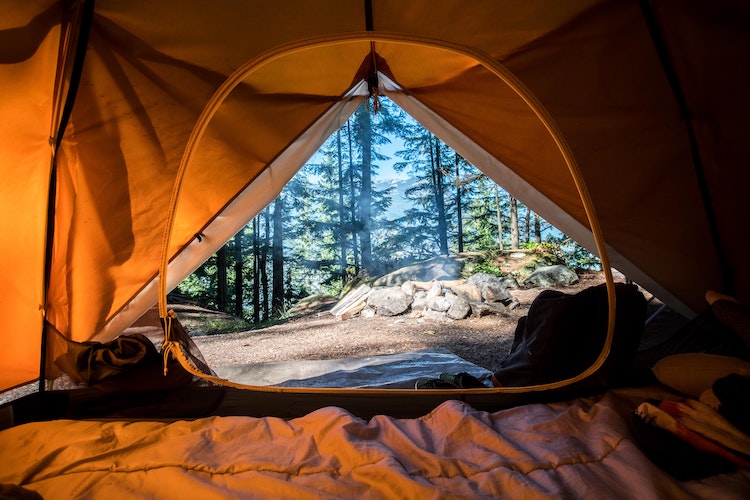The mighty Cache La Poudre River is more than just a pretty river flowing through Fort Collins. This long, crystal clear river is a destination for all sorts of outdoor recreation, including hiking, biking, kayaking, rafting, camping and more — all of which are better enjoyed by gorgeous river views and access to the ice cold water, providing a respite from Colorado’s hot summer days.
The river has carved out a canyon over time, creating towering cliffs and interesting rock formations dotted with ponderosa pines, native grasses, and aspen trees. Whether you simply want to catch glimpses of the river on a leisurely drive or get immersed in its waters via inflatable raft, we’re sharing all you need to know about this beautiful treasure winding through Northern Colorado.
All About the Cache La Poudre River

Pronounced “kash la pooh-der,” the name “Cache La Poudre” is French and translates to “hide the powder.” This phrase refers to an incident in the 1820s when French trappers had to bury part of their gunpowder along the river banks during an intense snowstorm. Referred to by locals as “the Poudre,” the river extends from the high peaks in Rocky Mountain National Park all the way a few miles east of Greeley, where it runs into the South Platte River, dropping a total of 7,000 feet along the way. The river is 126 miles long and is the only nationally designated “Wild & Scenic” river in the state of Colorado.
Designated by Congress in 2009, the Cache La Poudre River Natural Heritage Area is one of 55 National Heritage Areas in the United States and was the first to be established west of the Mississippi. The area extends for 45 miles and includes the land within the 100-year flood plain of the Poudre. Here, visitors can walk or bike along the Poudre River Trail, access the river to go kayaking or rafting, and visit the many historical sites to learn more about the area’s unique history.
History
The Poudre has a varied history, dating back to the Native American tribes who occupied the valley on a seasonal basis, using the river as a place to gather plant foods like roots, cattails and chokecherries.
The river played a significant role in the history of Northern Colorado, as it contributed to the development of the Western Water Law and the evolution of complex delivery systems. It also contributed to the development of Fort Collins itself! In 1864, a flood destroyed the military post, Camp Collins, which was situated near the river in La Porte. The camp was relocated and renamed Fort Collins, although a fort was never rebuilt, and the area evolved into the current city of Fort Collins. Much of the settlement in the area happened in the 1870s and 1880s, as mining and railroad building took off throughout the region. The river was even used as a tool during the railroad boom, as trees were cut for railroad ties and shipped by boat down the river.
Learn more about the history of the Poudre and the surrounding area here — or by visiting the many regional historical sites, including the 1883 Fort Collins Water Works, Centennial Village Museum, and the Poudre Learning Center.
Hiking

Hiking is one of the most common activities for river goers, as it requires little to no equipment — and can be enjoyed all year long! The scenic Poudre River Trail is one of the best ways to experience the river on foot. This 21-mile paved trail is popular amongst hikers, runners, cyclists and inline skaters and features gentle grades passing through forests and open areas alike. The trail goes through several parks and natural areas, giving you plenty of places to stop along the way for a picnic or to cast a line in the water. You can access the Poudre River Trail at several different locations along the way, including Island Grove Park, 71st Avenue, 83rd Avenue, or the Kodak headquarters. Click here for an interactive map of the trail, which includes more access points to choose from!
Biking
The Poudre River Trail is popular for bikers as well, as the paved trail offers several access points and varied scenery. But there are other walking and biking routes along the river worth trying, including Pleasant Valley Trail, the trail from Lions Park to Summit Drive, Summit View Drive to River Bluffs, and more. To learn more about each trail, including specific information for bikers, click here!
Camping

To fully experience nature and get immersed in the area, you can pitch your tent for a night under the stars — with sounds of the river lulling you to sleep. There are 11 campgrounds situated along the Poudre, five of which accept reservations and six of which operate on a first come, first served basis. Campgrounds are typically open from mid to late summer and quickly fill up by Wednesday or Thursday — so you may want to opt for a reservation-only campground (and book in advance) so you can ensure you have a space to pitch your tent! Learn more about each campground and make your reservations here.
Rafting
Cruising along the river on a massive inflatable raft is one of the most unforgettable experiences you and your family can have! AVA provides a variety of rafting trip options on the Poudre, from Class III rapids on the Lower Poudre for first-timers to the Class IV excitement of Mishawaka Falls for more experienced paddlers. The rafting season generally extends from May through August — so book your trip while you can! Click here to learn more about each trip and check out this First-Timer’s Guide to Rafting on the Cache La Poudre River to get prepared for your adventure.
Kayaking

While it may be tempting to just stick your kayak in the river and see what happens, you should do a bit more planning and preparation beforehand to make sure the experience is both safe and enjoyable. The Filter Run is an excellent portion of the river for beginner padders who want to experience some rapids — without paying the consequences. This 2.4-mile segment has class II-III rapids, which includes some swift-moving sections and a few exciting runs here and there. There are several put-in options, including Gateway Natural Area ($5 per day) and a variety of take-out options, such as Picnic Rock. Learn more about where to park — and other important details about kayaking the Filter Run — here.
Fishing
The Poudre is also an excellent place to cast a line — as it is packed with rainbow, brown and brook trout, plus many other types of fish. Check out this helpful brochure from Colorado Parks & Wildlife, which has information about exactly where to go, and what types of fish you can expect at each fishing spot. And consult our Northern Colorado Fishing Guide before you head out!
Driving

If reading about all this physical activity has you exhausted, take heart — you can also see and appreciate the river on a scenic, leisurely drive. In fact, driving along the river is the fastest and easiest way to see it all! Take a look at the many Poudre River driving tours, which includes maps, important details about the drives, and things to keep an eye out for along the way.
Take It All In!
No matter how you explore the Poudre, we hope you have the opportunity to appreciate its history and revel in its beauty and strength!
Comments